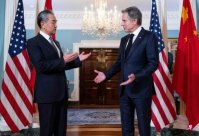Source: Bloomberg
Author: Rebecca Choong Wilkins, Shawn Donnan
China is providing loans to developing countries in reform countries. This strategy may help it maintain its increasing leading advantage of the United States and its seven countries (G7) allies.
A new report released by William and Mary, Virginia Public University in the United States, shows that Beijing has begun to give up a large -scale bilateral protocol when he first proposed the "Belt and Road" initiative ten years ago, and instead supports cooperation in cooperation.Loans to reduce financial risk exposure.
As a result, the loan fell moderately, but China still won the G7 country.The current latest data of the college's research institution Aiddata shows that in 2021, China provided US $ 79 billion in assistance and loans to low -income countries, surpassing US $ 61 billion in the United States.The amount of commitment made by the World Bank in the same year was about $ 53 billion.
Thereport pointed out that in comparison, from 2013 to 2017, Beijing provided about $ 117 billion in financing to developing countries each year, almost three times that of Washington.This is much higher than before.
Chinese President Xi Jinping has initiated the "Belt and Road" initiative in the past ten years, and many changes have taken place.As several countries receiving financing announced sovereignty breach, China has been criticized as an irresponsible lender.The close diplomatic relations between Xi Jinping and Russian President Putin and the situation with the geopolitical tensions in the West have also exacerbated contradictions, weakening the interests of European countries in the "Belt and Road".
These issues, coupled with the slowdown of the domestic economy, may force China to re -consider the model of its loan.This world's second largest economy hopes to maintain its financial influence in the development of the world.
"China will not stand by and allow its flagship global infrastructure initiative to destroy it once. This will not happen," said Brad Parks, an executive director and the main author of Aiddata."Beijing is actually performing a rescue task. It is examining its global investment portfolio and the crisis of fire extinguishing."
Careful stance
China's more cautious position must be partly attributed to many countries that borrow from it.
According to Aiddata, about 80%of the loans provided by Beijing to developing countries have flowed to developing countries facing financial difficulties.The database of the research institution covers a financial instrument of approximately $ 1.34 trillion between 165 countries between 2000 and 2021.These include some projects promised in this time period, but may not be started until this year.
Parks pointed out that some re -calculation shows that China's long -term views have changed, which has formulated new loans and project guarantee measures for this.China has begun to outsourcing risk analysis to international institutions such as International Financial Corporation (IFC).It also invests through the lending lending led by Western Commercial Banks.
Aiddata said that this has greatly improved China's loan and investment efficiency of projects in developing countries.Although it uses Western institutions to achieve this, most projects invested by the country are still built by Chinese contractors.
TheReport also pointed out that the transaction structure in China has changed.Among the non -emergency loan portfolio provided by China to low -income countries, half of them are arranged through the CBR loan.Aiddata said more than 80%of them had Western commercial banks and multilateral institutions.
"Beijing is now performing like an investment portfolio that pursues the maximum income," Parks and other authors of the report wrote, and said that Western decision makers know little about the country's efforts to de -risk."Washington, London, and Brussels are more and more likely to compete in the old version of the old version of the old version."



